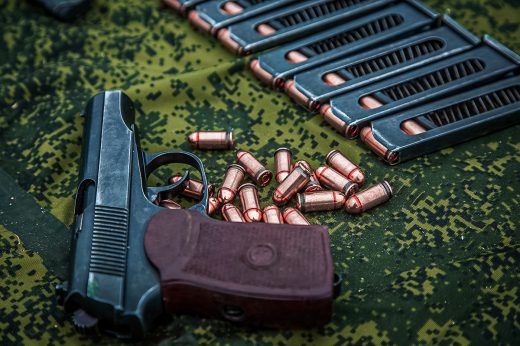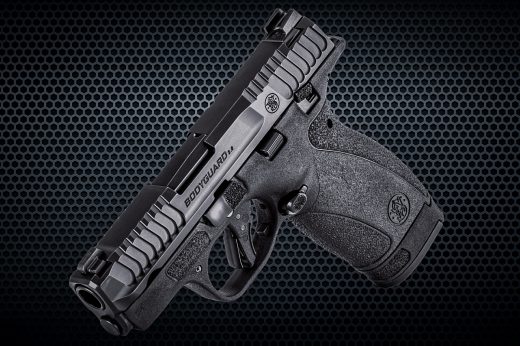In considering the FNX 45 pistol made by the storied Belgian firearms company FN Herstal, I discovered two remarkable things — more good pistols came out of the U.S. Army’s Joint Combat Pistol Program than I thought, and combat-oriented .45 ACP pistols are still being innovated today, more than 110 years after the fat, slow cartridge hit the scene. Okay, the pistol competition is already about 20 years old, and the FNX 45 Tactical is over a decade old, but you get my point.
Now this isn’t the pistol trial that gave us the SIG Sauer M17/M18 that’s been adopted by every branch of the military. This was an earlier program started by USSOCOM to replace the Beretta M9 back in late 2005 that merged two earlier programs: the Army’s Future Handgun System and the Special Operations Forces Combat Pistol.
Tactical Origins of the FNX 45: A Pistol Trial to Nowhere
They were looking for a gun with the new features sported by civilian polymer-framed pistols that the M9 lacked, but they also wanted to ditch the 9mm for the U.S. military favorite — .45 ACP. In addition to the chambering, all entries were required to have an integrated accessory rail, night sights, and threaded barrels capable of accepting a suppressor.

The program didn’t go far. In 2006, it was massively scaled down, and the Army pulled out. It was canceled completely later that year and replaced by a new Joint Combat Pistol Study.
The FN entry was the FNP45-USG, the earliest precursor to the FNX line. The FNP eventually became an entire line of polymer-framed, hammer-fired pistols made in Columbia, South Carolina, by FNH USA (the gunmaker’s U.S.–based division). The gun hit the market in that same year, 2006, chambered in the popular semi-auto handgun cartridges of the time: 9mm, .40 S&W, .357 SIG, and .45 ACP.
The pistol had a number of features added that the military trial required, most of which eventually translated to the FNX-45 Tactical model. These included ambidextrous decocking levers, a reversible mag release, and an ambidextrous slide release.
It was up against a few other guns you can still find in gun shops today, including the Beretta Px4 Storm, the Glock 21 FS, the Heckler & Koch HK45C, the SIG P220 Combat, the Smith & Wesson M&P45, and the Springfield XD, in addition to the Para-Ordnance LDA 1911 and the Taurus PT 24/7 OSS, which was a big-selling line for Taurus, replacing a number of its older polymer-framed guns.

Of course, the FNP had a rail as required by the trial, and FN touted that the pistol, at the time, was the only polymer-framed gun with fully replaceable frame rails. Who cares? Supposedly this would allow the pistol to be easily rebuilt after extensive firing, which extends service life — something else that was likely a holdover from its military roots.
The FNP pistols, like the FNX line after it, use a Browning-style cam system with an external extractor, and the trigger module is an individual unit housed in the frame. The DA/SA pistol is easily disassembled via a typical takedown lever near the front of the frame. Being a hammer gun, no trigger pull is necessary to field strip the gun.
RELATED – Glock 26: Pocket-Sized Perfection for Three Decades
FNX 45 Tactical: Features
Eventually, FNX models replaced the FNP line. The FNX 45 Tactical model is closest in substance to the gun entered in the long-dead Joint Combat Pistol Competition but with a number of modern improvements.
The standard magazine, while not completely flush with the grip, holds 15 rounds of .45 ACP, which is an extremely solid capacity for that chambering.
The frame contains the most changes from the FNP. The FNX 45’s frame has deep checkering for a positive grip and a lower bore axis for better control, less muzzle flip, and more accurate follow-up shots, along with a grip angle designed to enhance natural point of aim and, by extension, point shooting.
All controls are fully ambidextrous, including the mag release. Harkening back to the SOCOM requirements, the 5.3-inch barrel is threaded for a suppressor, compensator, or other muzzle devices. Because, despite its shortcomings compared to the 9mm, the inherently slow .45 plays very well with suppressors.
The stainless-steel slide comes with high-profile combat night sights for easy use with a can and also includes two mounting plates for use with several popular handgun red dots. In fact, considering this gun came out in 2012, it had a shit ton of features that would have been considered cutting edge at the time and are pretty standard for polymer gun models today, like an optics-ready slide.
The gun also comes with some replacement backstrap options so you can quickly customize the grip feel, and it retains the replaceable steel rails of the FNP.

RELATED – Dream Guns: How We Would Spend $6,000 on One Firearm
How It Stacks Up
People love this pistol. It’s a pie-in-the-sky gun for lots of shooters because, compared to a Glock or an M&P, with an MSRP of $1,379, it’s a bit pricey. But you will rarely run into someone who owns or carries an FNX 45 Tactical who doesn’t like it — they usually rave about it, and, frankly, many of them are a little hoity-toity about it in ways HK loyalists used to be.
And they have the right to be, kind of. It’s an amazing pistol that’s built like a tank with a pile of features. Can that big ol’ price tag be justified when you compare it to guns like Smith & Wesson’s M&P45 M2.0 with an optics-ready slide and threaded barrel with a price less than half that of an FNX 45 Tactical?
You can always fall back on capacity. The aforementioned S&W pistol holds just 10 rounds — 10 to 12 rounds is pretty typical for double-stack .45s — whereas the FN holds 15. Springfield’s XD Elite line has the features, but there’s no .45 option, and the XD models that come in .45 ACP are all bare-bones, 10-rounders.
Beretta’s .45-caliber entry in the pistol competition still exists as the Px4 Storm SD Type F, but its extended barrel is not threaded for some unimaginable reason, the slide is not milled for optics, and it comes with 9- and 10-round magazines.
Plus, it has Beretta’s infernal slide-mounted manual safety, which I hate with a passion. And the gun can’t be carried cocked and locked. You can only cock the hammer with the safety disengaged, and when you engage it, it automatically decocks the hammer. All that for a price that creeps close to the FN at $1,149. I had one of these for a while — it was less than impressive at the range, and it’s no longer in my safe.
After all that, if you want a .45 ACP pistol with the highest capacity out there (without an extended mag) and all the features you want on a tactical handgun, it’s hard to go wrong with the FNX 45 Tactical. And while the MSRP is around $1,300, real-world prices will usually be in the high $800s.
And when you get one, you can be the cool kid at the range or have one badass combat pistol as your EDC pistol.
RELATED – Volcanic Pistol: The First Repeating Pistol — And a Failure
FNH-USA FNX 45 Tactical Specs and Features:

Chambering: .45 ACP
Action: Double Action/Single Action
Barrel: Cold hammer forged stainless steel
Barrel Length: 5.3 inches
Capacity: 15 rounds (10-round mags available)
Weight: 33.3 ounces
Height: 6.5 inches
Width: 1.58 inches
Trigger Pull: Adjustable, 8.8 to 12.1 pounds, or 3.96 to 5.06 pounds
Sight Radius: 6.4 inches
Sights: Raised 3-Dot Trijicon green tritium night sights for use with suppressors
Features
- Slide cut and threaded for red-dot electronic sights
- Fully ambidextrous decocking/safety levers, slide stop lever, and magazine release
- Polished chamber and feed ramp
- Rear sight can be used to cycle action one-handed
- External extractor with loaded chamber indicator
- Front and rear cocking serrations
- Polymer frame with steel slide rails
- 4 interchangeable backstraps
- Serrated trigger guard
Ships With:
- 2 15-round magazines with an extended base pad or 2 10-round magazines
- Sight mounting kit with plates and screws
READ NEXT – Volcanic Pistol: The First Repeating Pistol — And a Failure










Comments